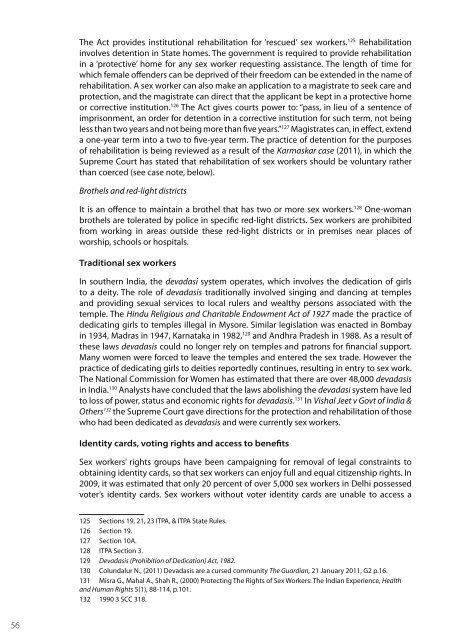SEX WORK AND THE LAW - HIV/AIDS Data Hub
SEX WORK AND THE LAW - HIV/AIDS Data Hub
SEX WORK AND THE LAW - HIV/AIDS Data Hub
You also want an ePaper? Increase the reach of your titles
YUMPU automatically turns print PDFs into web optimized ePapers that Google loves.
The Act provides institutional rehabilitation for ‘rescued’ sex workers. 125 Rehabilitation<br />
involves detention in State homes. The government is required to provide rehabilitation<br />
in a ‘protective’ home for any sex worker requesting assistance. The length of time for<br />
which female offenders can be deprived of their freedom can be extended in the name of<br />
rehabilitation. A sex worker can also make an application to a magistrate to seek care and<br />
protection, and the magistrate can direct that the applicant be kept in a protective home<br />
or corrective institution. 126 The Act gives courts power to: “pass, in lieu of a sentence of<br />
imprisonment, an order for detention in a corrective institution for such term, not being<br />
less than two years and not being more than five years.” 127 Magistrates can, in effect, extend<br />
a one-year term into a two to five-year term. The practice of detention for the purposes<br />
of rehabilitation is being reviewed as a result of the Karmaskar case (2011), in which the<br />
Supreme Court has stated that rehabilitation of sex workers should be voluntary rather<br />
than coerced (see case note, below).<br />
Brothels and red-light districts<br />
It is an offence to maintain a brothel that has two or more sex workers. 128 One-woman<br />
brothels are tolerated by police in specific red-light districts. Sex workers are prohibited<br />
from working in areas outside these red-light districts or in premises near places of<br />
worship, schools or hospitals.<br />
Traditional sex workers<br />
In southern India, the devadasi system operates, which involves the dedication of girls<br />
to a deity. The role of devadasis traditionally involved singing and dancing at temples<br />
and providing sexual services to local rulers and wealthy persons associated with the<br />
temple. The Hindu Religious and Charitable Endowment Act of 1927 made the practice of<br />
dedicating girls to temples illegal in Mysore. Similar legislation was enacted in Bombay<br />
in 1934, Madras in 1947, Karnataka in 1982, 129 and Andhra Pradesh in 1988. As a result of<br />
these laws devadasis could no longer rely on temples and patrons for financial support.<br />
Many women were forced to leave the temples and entered the sex trade. However the<br />
practice of dedicating girls to deities reportedly continues, resulting in entry to sex work.<br />
The National Commission for Women has estimated that there are over 48,000 devadasis<br />
in India. 130 Analysts have concluded that the laws abolishing the devadasi system have led<br />
to loss of power, status and economic rights for devadasis. 131 In Vishal Jeet v Govt of India &<br />
Others 132 the Supreme Court gave directions for the protection and rehabilitation of those<br />
who had been dedicated as devadasis and were currently sex workers.<br />
Identity cards, voting rights and access to benefits<br />
Sex workers’ rights groups have been campaigning for removal of legal constraints to<br />
obtaining identity cards, so that sex workers can enjoy full and equal citizenship rights. In<br />
2009, it was estimated that only 20 percent of over 5,000 sex workers in Delhi possessed<br />
voter’s identity cards. Sex workers without voter identity cards are unable to access a<br />
125 Sections 19, 21, 23 ITPA, & ITPA State Rules.<br />
126 Section 19.<br />
127 Section 10A.<br />
128 ITPA Section 3.<br />
129 Devadasis (Prohibition of Dedication) Act, 1982.<br />
130 Colundalur N., (2011) Devadasis are a cursed community The Guardian, 21 January 2011, G2 p.16.<br />
131 Misra G., Mahal A., Shah R., (2000) Protecting The Rights of Sex Workers: The Indian Experience, Health<br />
and Human Rights 5(1), 88-114, p.101.<br />
132 1990 3 SCC 318.<br />
56
















